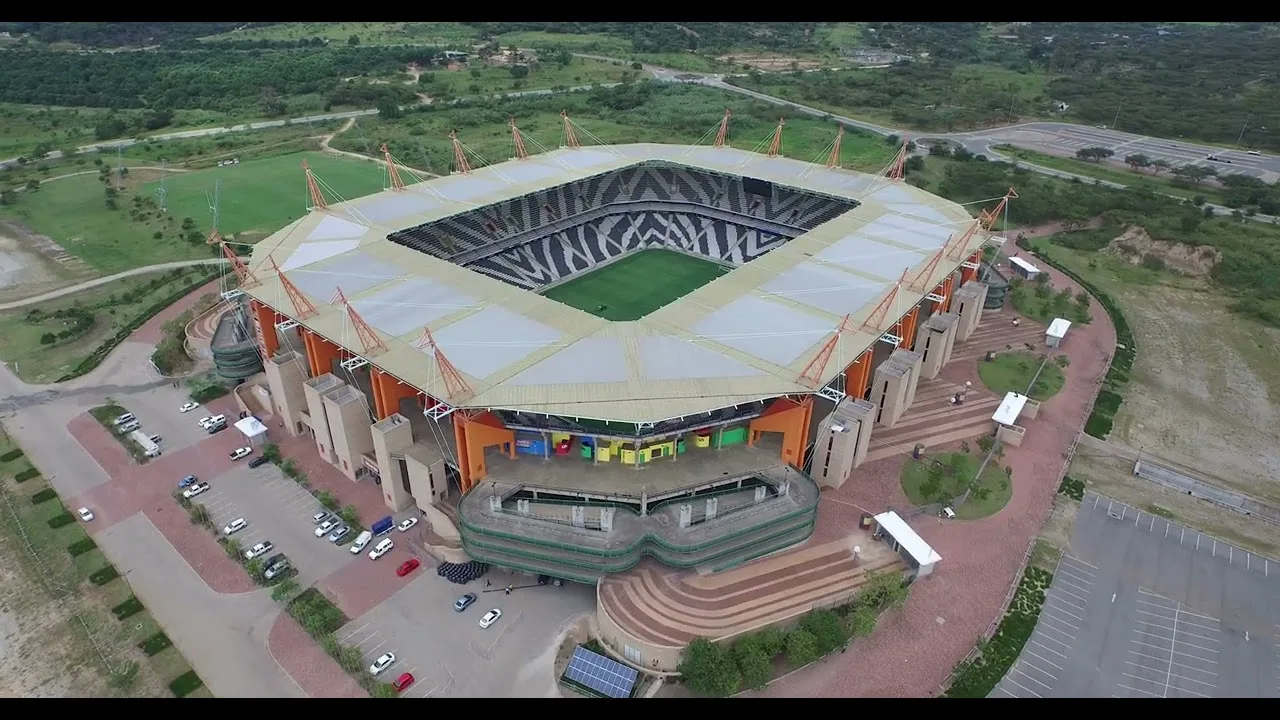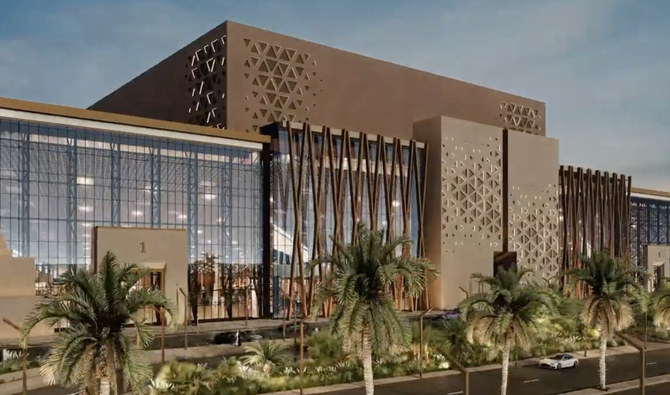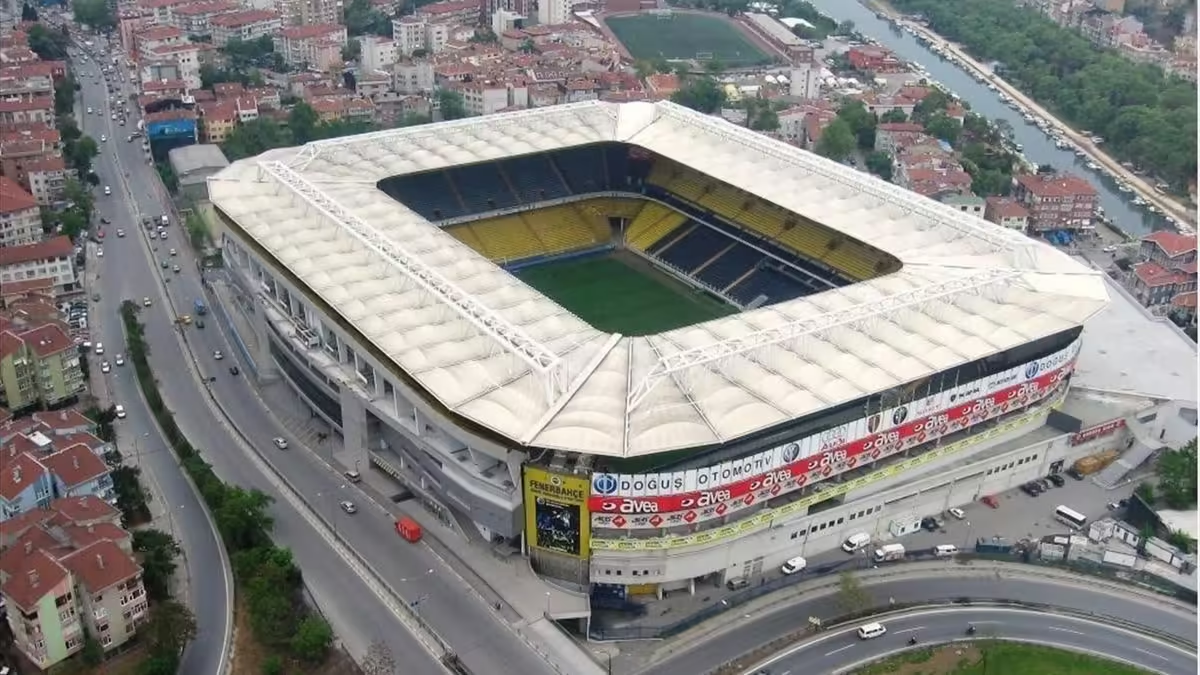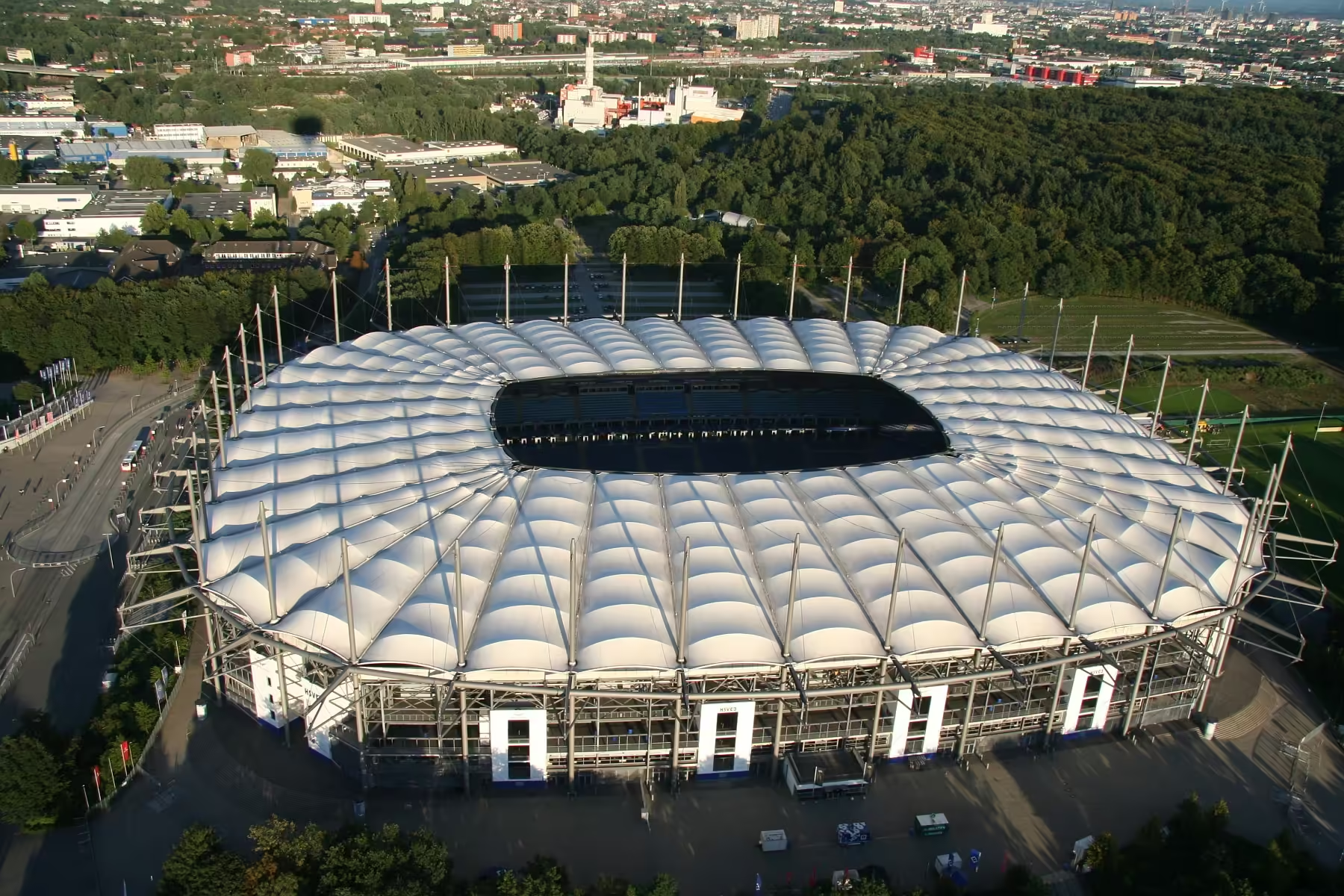Mbombela Stadium is a multi-purpose sports facility located in Mbombela, South Africa. It was one of the five new stadia constructed for the 2010 FIFA World Cup Soccer Tournament, and it hosted four matches during the tournament. The stadium has a seating capacity of 43,500 and is considered one of the most impressive sports venues in the country.
Located in the Mpumalanga province of South Africa, Mbombela Stadium is easily accessible from all major cities in the region. The stadium’s unique design reflects the nearby Kruger National Park, with 18 majestic orange giraffe-like roof supports and seats arranged in the pattern of zebra stripes. The stadium is the home ground for the Pumas, a Currie Cup rugby union team, and the Springboks, the national team. It also hosts various soccer and rugby union matches throughout the year.
Key Takeaways
- Mbombela Stadium is a multi-purpose sports facility located in Mbombela, South Africa, with a seating capacity of 43,500.
- The stadium’s unique design reflects the nearby Kruger National Park, with 18 roof supports resembling giraffes and seats arranged in the pattern of zebra stripes.
- The stadium is home to the Pumas, a Currie Cup rugby union team, and the Springboks, the national team, and hosts various soccer and rugby union matches throughout the year.
Location and Accessibility
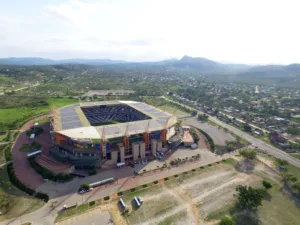
Geographical Setting
Mbombela Stadium is located in the city of Mbombela, which is the capital of the Mpumalanga province of South Africa. The stadium is situated in the Mbombela Central Business District, adjacent to the N4 highway, which connects the city to Johannesburg and Pretoria. The stadium is also located near the Crocodile River, which is a popular tourist destination for its scenic beauty and wildlife.
Transport Links
Mbombela Stadium is easily accessible by road, with ample parking available for visitors. The stadium is located approximately 10 km from the Kruger Mpumalanga International Airport, which is serviced by several domestic airlines. The airport offers direct flights to Johannesburg, Durban, and Cape Town, making it easy for visitors to travel to Mbombela from other parts of South Africa.
In addition, the stadium is located near several major bus terminals, including the Mbombela Bus Terminal and the Mpumalanga Bus Terminal. These terminals offer regular bus services to other cities in South Africa, making it easy for visitors to travel to Mbombela by bus.
For visitors who prefer to travel by train, the nearest railway station is located in Nelspruit, which is approximately 15 km from Mbombela. The station is serviced by several trains that connect Nelspruit to other major cities in South Africa, including Johannesburg and Pretoria.
Overall, Mbombela Stadium is easily accessible by road, air, and rail, making it a convenient destination for visitors from all over South Africa.
Design and Construction
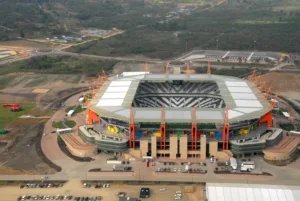
Architectural Overview
Mbombela Stadium is a modern sports facility located in Mbombela, South Africa. The stadium was designed by GMP Architekten, a German architectural firm, and completed in 2009. The design of the stadium reflects the surrounding natural beauty of the area, specifically the nearby Kruger National Park.
The stadium has a unique and striking design, with 18 roof supports that resemble giraffes, and the seats form a zebra pattern. The exterior facade is made of glass panels and light-toned concrete, which perfectly harmonizes with the natural surroundings. The stadium has a seating capacity of 43,500, and almost all of the seats are under the roof.
Construction Timeline
The construction of Mbombela Stadium started in 2007, and it was one of the five newly constructed stadiums for the 2010 FIFA World Cup. The construction process was completed in two years, and the stadium was inaugurated in 2009. The construction process faced several challenges, including strikes, labor disputes, and funding issues. However, the stadium was completed on time and within budget.
Sustainable Features
Mbombela Stadium has several sustainable features that make it an environmentally friendly facility. The stadium has a rainwater harvesting system that collects rainwater and stores it in tanks for later use. The stadium also has a solar water heating system that provides hot water for the stadium’s facilities. The stadium’s lighting system is energy-efficient, and it uses LED lights that consume less electricity.
In conclusion, Mbombela Stadium is a modern sports facility with a unique and striking design that reflects the natural beauty of the surrounding area. The construction process faced several challenges, but the stadium was completed on time and within budget. The stadium also has several sustainable features that make it an environmentally friendly facility.
Events and Usage
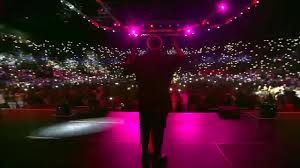
Major Tournaments
Mbombela Stadium was one of the ten venues for the 2010 FIFA World Cup, which was held in South Africa. The stadium hosted four group stage matches, one round of 16 match, one quarterfinal, and the third-place playoff. The stadium’s capacity during the tournament was 43,589 spectators.
Apart from the World Cup, the stadium has also hosted several major tournaments, including the 2011 African Cup of Nations, the 2014 African Nations Championship, and the 2016 COSAFA Cup. These tournaments have brought thousands of football fans to the stadium and have contributed significantly to the local economy.
Regular Events
In addition to hosting major tournaments, Mbombela Stadium is also used for regular events. The stadium is the home ground of the Pumas, a South African rugby union team that plays in the Currie Cup and the Rugby Challenge. The Pumas have a dedicated fan base, and their matches at the stadium are well-attended.
The stadium is also used for concerts, festivals, and other events. For example, the stadium has hosted the Mbombela Jazz Festival, which features some of the best jazz musicians from South Africa and the rest of the world. The stadium’s location, facilities, and capacity make it an ideal venue for large-scale events.
Overall, Mbombela Stadium is a versatile and well-utilized venue that has played a significant role in the development of sports and entertainment in the Mpumalanga province of South Africa.
Facilities
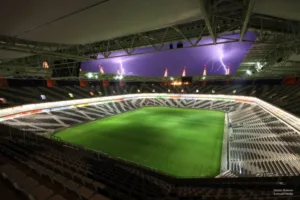
Seating Capacity
Mbombela Stadium has a seating capacity of 43,589, making it one of the largest stadiums in South Africa. The stadium has four main stands, namely the north, south, east, and west stands. The north and south stands are the largest, with a seating capacity of 13,000 each. The east and west stands have a seating capacity of 8,000 and 9,000, respectively. The stadium also has 174 wheelchair accessible seats, located in various sections around the stadium.
VIP Areas
Mbombela Stadium has a number of VIP areas, including 30 corporate suites and 800 tiered seats. The corporate suites are located on the top level of the stadium and offer a panoramic view of the field. Each suite can accommodate up to 20 people and comes equipped with a private bar, lounge area, and catering facilities. The tiered seats are located on the west side of the stadium and offer a more exclusive viewing experience.
Amenities
Mbombela Stadium has a range of amenities for visitors, including a restaurant, bar, and two buffet serving areas. The restaurant is ideal for conferences and large gatherings, with a seating capacity of 450 guests at round tables and 600 guests in conference style. The bar area is located on the first level of the stadium and offers a wide variety of drinks and snacks. The stadium also has ample parking facilities, with a total of 4,000 parking bays available for visitors.
Overall, Mbombela Stadium offers a world-class experience for sports fans and visitors alike, with state-of-the-art facilities and amenities to ensure a memorable visit.
Economic Impact
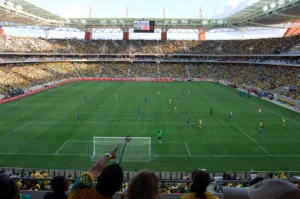
Mbombela Stadium has had a significant economic impact on the city of Mbombela and the surrounding region. According to citizen.co.za, the stadium has generated over R100 million in revenue from events held at the venue. This revenue has been generated from various sources, including ticket sales, merchandise sales, and concessions.
In addition to generating revenue from events, Mbombela Stadium has also created jobs in the region. The stadium employs a significant number of people, including security personnel, event staff, and maintenance workers. These jobs have provided an economic boost to the region, helping to reduce unemployment rates and improve the standard of living for many people.
Mbombela Stadium has also helped to raise the profile of Mbombela and the surrounding region. The stadium has hosted numerous high-profile events, including the 2010 FIFA World Cup, which has helped to put Mbombela on the map as a destination for sports and entertainment. This increased visibility has helped to attract investment to the region, further boosting the local economy.
Overall, Mbombela Stadium has had a positive economic impact on the city of Mbombela and the surrounding region. The stadium has generated significant revenue from events and created jobs in the region, while also helping to raise the profile of Mbombela as a destination for sports and entertainment.
Cultural Significance
Mbombela Stadium has played a significant role in South African sports history since its construction. It is one of the ten stadiums that hosted the 2010 FIFA World Cup, which was the first time that the tournament was held on the African continent. The stadium has also hosted several other international and local sporting events, including Rugby Union matches, music concerts, and cultural festivals.
The stadium’s design and architecture have become a source of pride for the local community and the entire country. The bowl-shaped design of the stadium, with almost all seats under the roof, ensures that spectators have an unobstructed view of the field and are protected from the elements. The unique roof design, which resembles a giraffe, has become an iconic symbol of the stadium and the city of Mbombela.
Mbombela Stadium has also become a hub for cultural and social events in the region. The stadium has hosted several music concerts, including performances by international artists such as Rihanna, Linkin Park, and Bon Jovi. The stadium has also been used for cultural festivals, such as the Mbombela Jazz Festival and the Lowveld Agricultural Show.
Moreover, the stadium has contributed to the economic growth of the region by attracting tourists and creating job opportunities for the local community. The stadium’s construction and maintenance have created job opportunities for local workers, and the influx of tourists during sporting and cultural events has generated revenue for local businesses.
In conclusion, Mbombela Stadium has become a cultural and social landmark in South Africa, attracting visitors from all over the world and contributing to the economic growth of the region. Its unique design and architecture have made it an iconic symbol of the city of Mbombela and a source of pride for the entire country.
Future Developments
Mbombela Stadium has already established itself as one of the most iconic sports facilities in South Africa, but there are still plans to further improve the stadium and its surrounding facilities.
One of the most exciting developments is the proposed expansion of the stadium’s seating capacity. Currently, the stadium has a capacity of 43,500 seats, but there are plans to increase this number to around 50,000 seats. This expansion would make the stadium even more attractive to major international sporting events, such as the Rugby World Cup or the Commonwealth Games.
Another development that is currently being discussed is the addition of a new hotel and conference center adjacent to the stadium. This would provide much-needed accommodation for visitors to the stadium and could also serve as a hub for sports-related conferences and events.
In addition to these physical developments, there are also plans to improve the stadium’s sustainability and reduce its environmental impact. This could involve the installation of solar panels or other renewable energy sources, as well as the implementation of more efficient waste management systems.
Overall, the future of Mbombela Stadium looks bright, with exciting plans in the works to further improve the stadium and its surrounding facilities.
Frequently Asked Questions
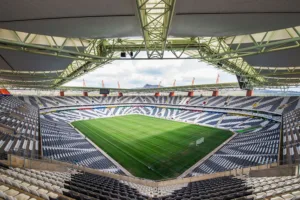
What is the seating capacity of Mbombela Stadium?
Mbombela Stadium is an all-seater stadium with a seating capacity of 43,500 seats, almost all under roof. [1] The stadium features 18 majestic orange giraffe columns that support the roof structure and black and white zebra skin patterned seating, creating a vibrant and friendly atmosphere. [2]
How can I purchase tickets for events at Mbombela Stadium and what are the prices?
Tickets for events at Mbombela Stadium can be purchased from the stadium’s official website or at the stadium’s ticket office. The prices for tickets vary depending on the event and the seating category. For more information on ticket prices, please visit the official website. [2]
What are the upcoming fixtures at Mbombela Stadium for the year 2024?
The fixtures for the year 2024 have not been announced yet. Please check the official website or the stadium’s social media pages for updates on upcoming events. [2]
Can I find a schedule of events for Mbombela Stadium in 2024?
The schedule of events for Mbombela Stadium in 2024 has not been released yet. Please check the official website or the stadium’s social media pages for updates on upcoming events. [2]
Who is the owner of Mbombela Stadium?
Mbombela Stadium is owned by the Mbombela Local Municipality. [1]
What are the rental costs for hosting an event at Mbombela Stadium?
The rental costs for hosting an event at Mbombela Stadium vary depending on the type of event, duration, and other factors. For more information on rental costs, please contact the stadium’s management team. [2]
Other Stadiums Articles:
Check Out: Tottenham Spurs Stadium: A Comprehensive Guide
Check Out: King Power Stadium: Home of Leicester City Football Club
Check Out: London Stadium: Home of West Ham United and the 2012 Olympics
Check Out: Villa Park Stadium: A Historic Venue for Football Fans
Check Out: St James’ Park Stadium: Home of Newcastle United Football Club
